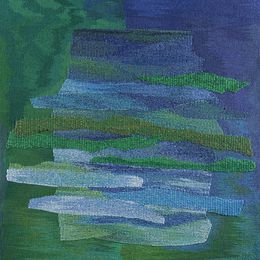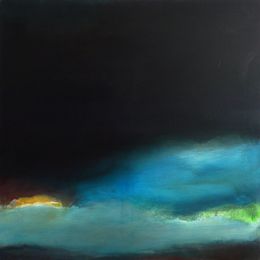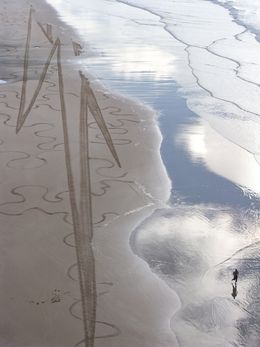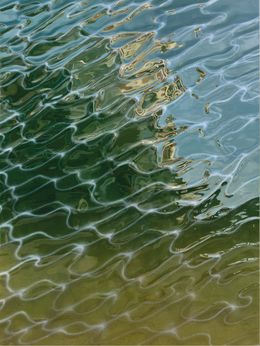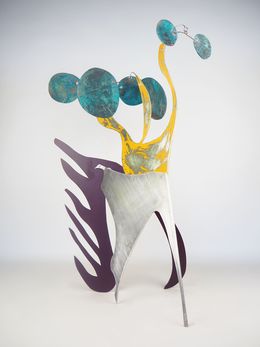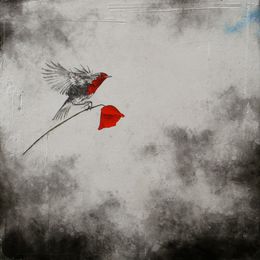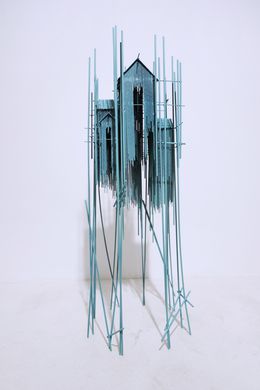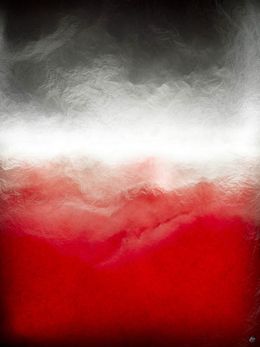
Meet Sam Dougados
Land art artist committed to the environment

Portrait of Sam Dougados working on a beach © Aurélie Monnet
Sam Dougados is a French contemporary artist based on the Basque Coast. Truly self-taught, he decorates the world's most breathtaking beaches with his poetic and ephemeral art. His land art creations take part in a strong environmental approach. Dougados is fascinated by nature; it serves both as a backdrop and as a subject for his art. Meet this environmentally committed artist with Artsper!
1. Hello Sam! Can you tell us about yourself and your journey as an artist?
Hello Artsper. I am 45 years old and live in a small village in the Landes region, near the Basque Country where I moved 22 years ago. I am originally from Strasbourg, which I left at the end of my studies for Biarritz, its waves and its quality of life. I have always had an interest in art and expression, materializing my sensitivity and my emotions, first in the form of poems during my teenage years, then naturally by trying different mediums and techniques, always self-taught.
In 2007, the Spacejunk art center in Bayonne offered me the opportunity to exhibit my cellular concrete sculptures in a gallery. At the beginning of 2008, following a redundancy, I decided to devote myself entirely to art, always looking to explore different mediums. That summer, I decided to try beach art, a technique I had discovered a year earlier while watching a surf video. It was under a Californian's rake.
The results were immediately interesting, with a very nice interaction between my drawings and the public and I was at the time the only one to really practice and develop this art in France. This allowed me to have a unique role, to stand out on the artistic scene and to share original works. Naturally, photography came to complete this art, firstly to keep a trace of my drawings whose lifespans never exceed 4 hours, then really as an additional proper technique, reflecting on my ephemeral works, trying to tell another story and to extract the poetry of the moment, sometimes just in a detail. Beach art is very similar in its approach, its life span, and its accessibility, to street art. It also pushed me a little more towards environmental art and towards outside installations, which I also create for client proposals.
2. What is your artistic approach and the message you wish to convey through your committed art?
I quickly noticed the interaction with the public because the unusual dimension, the ephemeral aspect and the visibility on a very touristy beach allowed me to reach many people very quickly. It's a way for me to highlight this environment, this magnificent nature that serves as a setting for my work, but which is also part of it and from which I draw my inspiration. Suddenly, by this intervention on the sand, people become aware of nature, its beauty and its fragility, the urgency to enjoy and protect it. And at the same time, people get to realize they are simply beings living in this environment... Awareness is the basis of everything: "Wonder is the first step towards respect" (N. Hulot).
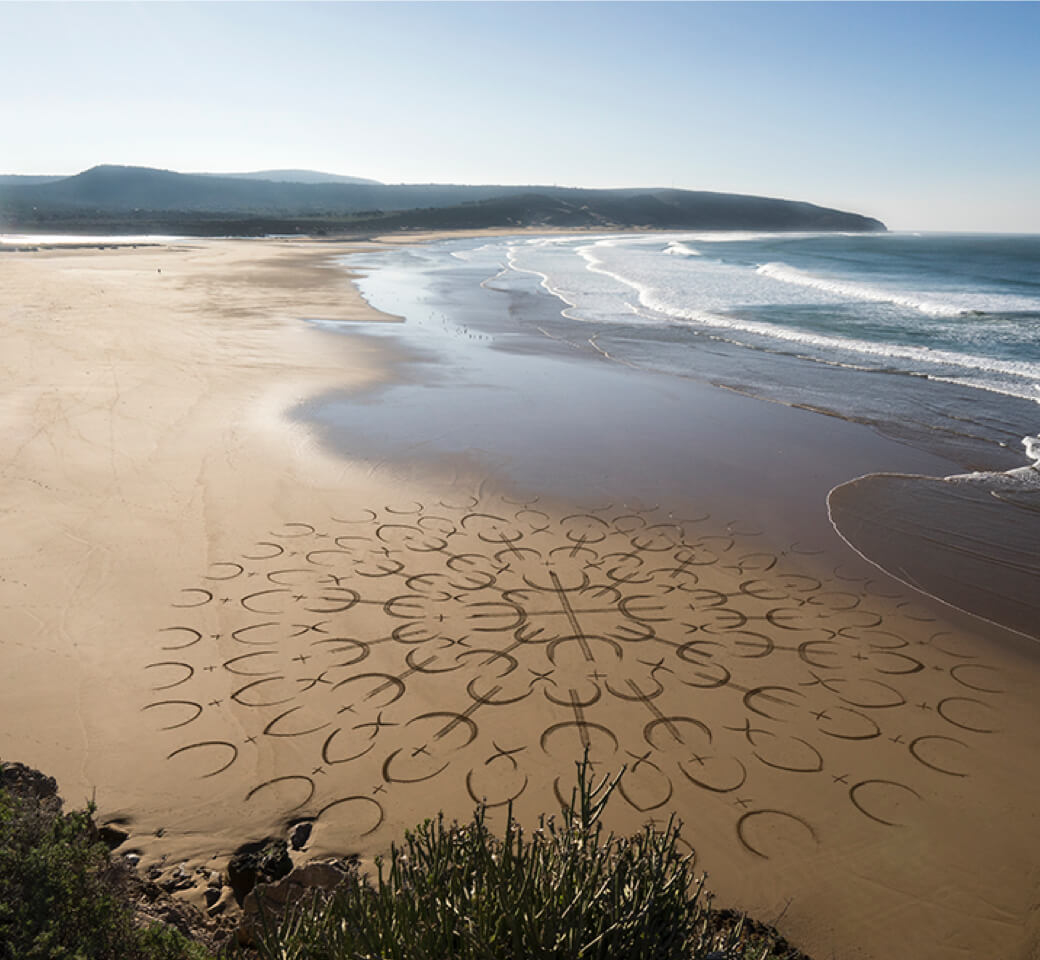
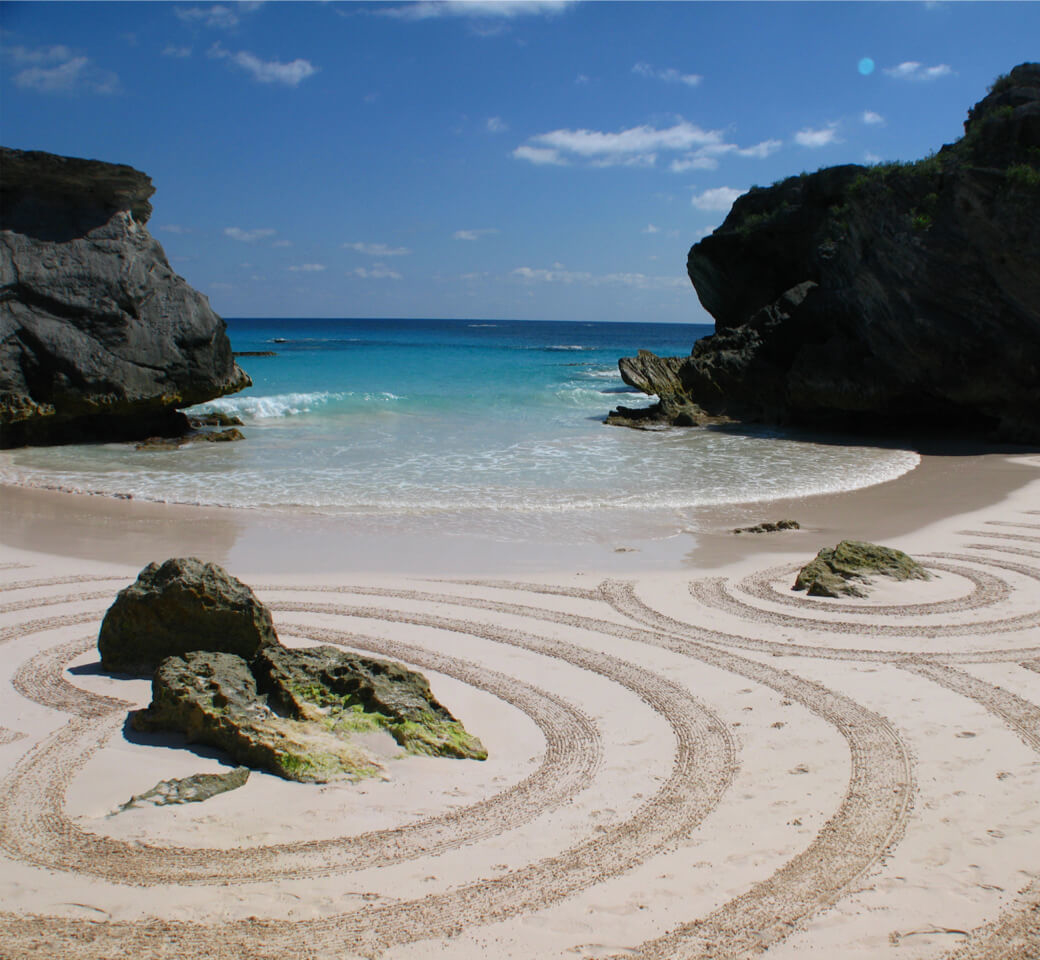
On the left: "The free man", drawn on a beach in Morocco. Artwork showcases the Berber sign "Yaz", emblem of the Berber people. Right: A beach in Bermuda.
3. As often with land art, your works are grandiose and ephemeral. They remain intact only a few hours before the tide erases them... Can you tell us about your creative process ?
My creative process is quite free, I do not necessarily seek complexity in my drawing or excess. I focus on the emotion in the final image, its poetry and harmony. I often improvise, either according to the place itself, the beach and its shape, its puddles, its rocks, its cracks that I can observe, or according to the country where I am, its history and its culture, such as the zellige and Islamic art in Morocco, the azulejos in Portugal etc. Of course I also have a sketchbook I can use whenever I have ideas.
I have been doing this for 13 years so it's not always easy to renew myself... But there's still a lot to do. Sometimes my work can also be just a sentence, bringing directly an explicit message that will generate thoughts. Then concretely, I look at the calendar of the tides where I am and I check the weather, of course, and work according to that, starting my drawing about 2 hours before the low tide.
Unfortunately I have these constraints which can sometimes be complicated to manage, especially when it comes to commissioned work. It requires adaptability because in case of rain or big swell, depending on the place, it's simply impossible to work and I have to postpone. Generally I use a simple leaf rake, nothing else, unless the design is complex with precise measurements and proportions, such as the 7 faces of the G7 presidents.
4. Why did you choose to produce ephemeral art? What about this notion inspires you?
When I discovered this art, I found it really beautiful, despite its "simplicity". A circle on an A4 sheet of paper does not generate much emotion, but a circle that has a 50m diameter on a beautiful and huge beach does, because it's not expected nor common or predictable, it's almost off-topic. The ephemeral aspect of land art reinforces even more this fascination I have for it, because it's obvious that the artwork will disappear very quickly after it's done. "Beauty, to be moving, must be ephemeral," said Robert Doisneau. This is also why we pay more attention to a flower, or to a butterfly, whose very short life incites us to enjoy ours and by allegory, it is the very principle of our life! We often become aware of what we miss when we've lost it, or of what was beautiful when it's destroyed. Environmental art, land art, are arts that push us to cherish little moments, life, and beauty.
I chose this art in a very natural way because I think it suits me. I live near the beach, I'm a surfer and I'm very sensitive to nature, so using this space as a studio was almost an evidence and a chance. Ephemeral art is a kind of performance, sometimes a race against the clock and this moment is rich in emotions. It's a mixture between an improvised dance, with the wind and the tide, and a meditation in full consciousness, awakening all 5 senses!
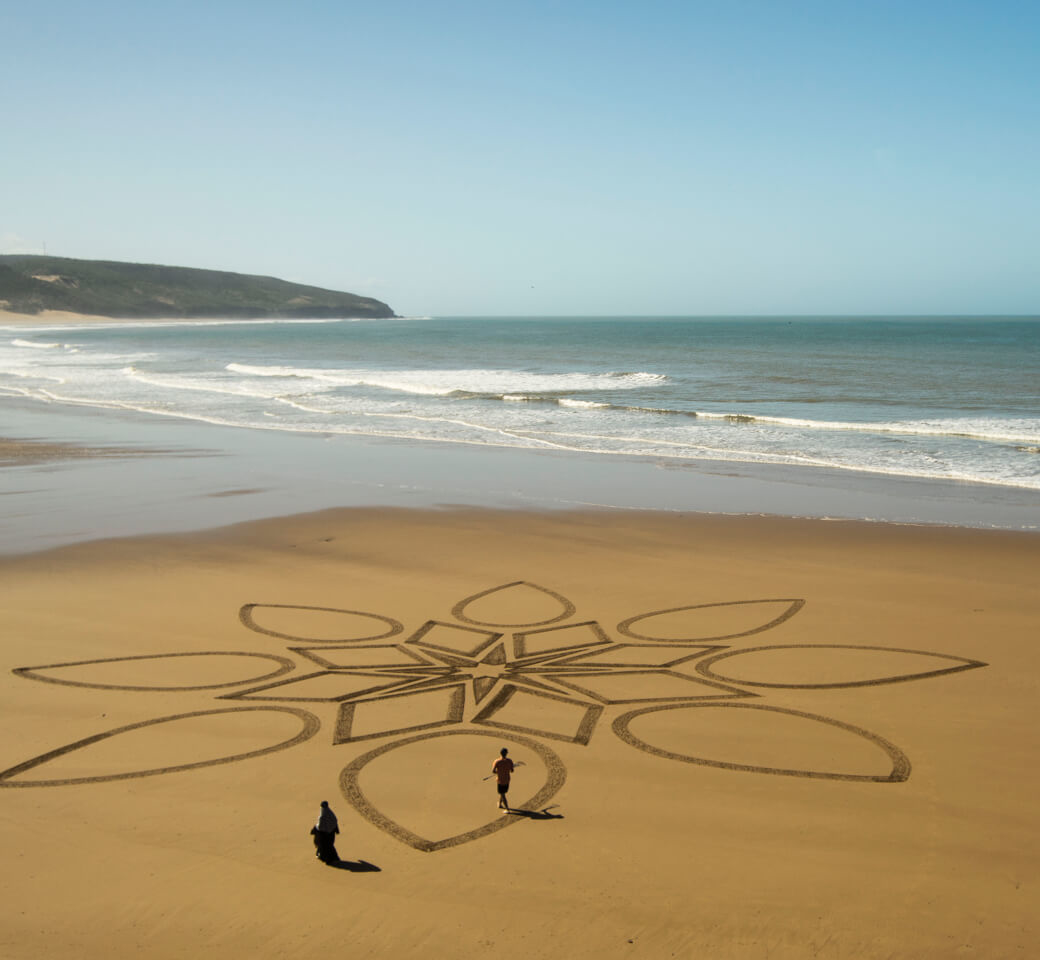
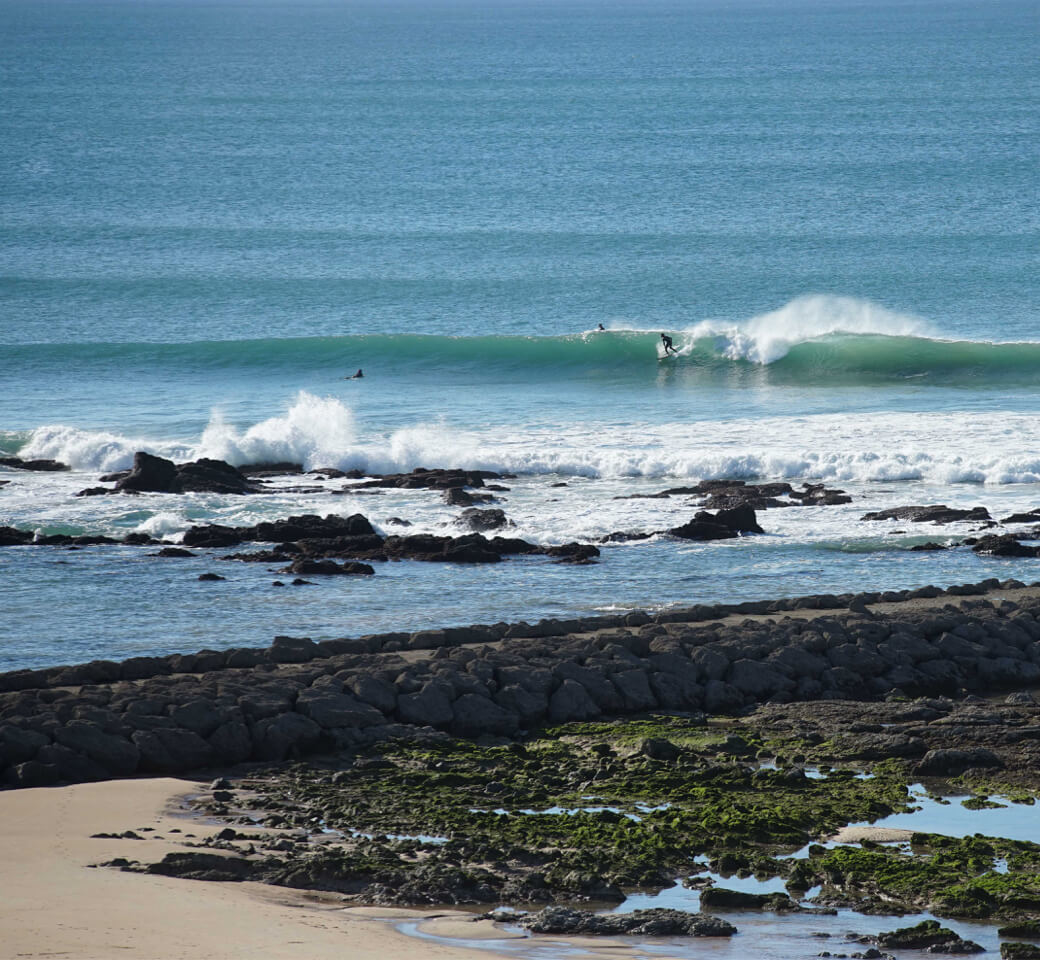
On the left: The artist in action on a beach in Tafedna, Morocco. On the right: A photo of the beautiful sea Sam Dougados has often surfed in autumn.
5. Your frescoes are sometimes several hundred square meters wide. How do you choose the places where you trace them? Where does this fascination for the beach come from?
When I started this job, I had the perfect beach for it, at the Côte des Basques just 5 minutes from my apartment when I lived in Biarritz. My work requires firm sand, covered by the tide so that it's wet and, ideally, a higher point-of-view to be able to take some distance in order to take pictures. So there are several parameters that are not so easy to have simultaneously.
Nowadays we have drones, but I don't use them often. Naturally I have drawn a lot on this beach but I particularly appreciate discovering new ones, on trips, in France or abroad, it's always inspiring after all these years. Sometimes I travel with my surfboard and my rake, often in Morocco where I particularly like to go. I have drawn in Bermuda on pink sand, in South Africa, or in Ireland for example. My work is also a way for me to show the beauty of our beaches, of the nature surrounding us or the one that is far away. It's not rare that people come to me while I'm working, to discuss, to ask me questions. It allows exchanges and encounters that one does not have in a studio or in a workshop.
6. What role does the Basque Coast and its biodiversity play in your art? Were you aware of the climate and environmental challenge when you were younger?
I'm particularly fond of the Basque Coast because I chose to live there more than 20 years ago after having discovered it during my first surfing course when I was 18. Since then, I've been able to see how the region has changed, quickly, too quickly even, victim of its success. I practice surfing, fishing, spearfishing, snowboarding... The region is perfect for all of these activities. It's a fabulous playground, rich in culture, varied landscapes and Spain is also a cultural asset. There are a lot of artists in the area because the quality of life and the lifestyle, the space and the freedom it offers allow maybe more creativity than elsewhere.
I don't think I was particularly aware of climate change when I was young, because these words and notions didn't really exist. On the other hand, my parents already recycled, I remember bringing bottles to the local recycling center for money - which would surely encourage people to recycle more if it was a thing now. We also had a vegetable garden and we used to go to the farm with a milk-pot like those of my grandparents. Since then, how many thousands of farms have disappeared, replaced by huge shopping malls?
Ecology is a fairly recent term, but in the past, products were natural, organic in essence: plastic bags used to be wicker baskets, and chemical fertilizers used to be compost and manure. Chemical agriculture products should be the ones with a special designation, but the lobbyists have played a big role in this! I still have a vegetable garden that we love to develop with my partner, to have as many original vegetable varieties as possible. Our chickens provide us with fresh eggs every day. We also found a farm 3 minutes away from us where we buy fresh milk and meat produced on the spot. We're lucky to have access to these goods and we seek as much as possible autonomy in accordance with our environment, without cutting ourselves off from society. Moreover it's tastier and often cheaper. The luxury of the 21st century, for me, is silence and space!
7. In view of the climate emergency, do you think it is up to artists to find solutions? And to go further, can art save the planet?
There is a climate emergency, there is no doubt about that. It's been going on for a long time, and those who do not want to believe in it are less and less numerous. But are we doing enough? Certainly not, otherwise the scientists' reports would not be increasingly more alarming. Is it the artists' role to find solutions? It's more the governments' and those who have power. Unfortunately, power rarely leads to good things. It leads to always yearning for more and more (like money, closely related). Current events demonstrate this aspect every day.
Will art save the planet? I don't think so, no! I'm an optimist by nature... but I'm also more and more realistic. The question today is no longer whether we are going to hit the wall, but whether we continue to run towards it or, on the contrary, whether we try to slow down the process and delay and mitigate the impact. It's not the world that we have to save, even if we abuse the planet as much as possible, violate it to the core, each day a little more, disfigure it, destroy the diversity of life, it will always recover... Certainly not as beautiful as we once knew it, just on the scale of our tiny lives, but we'll not be able to stop the spiral if we continue like this. We behave like parasites who, after having used and abused our host, change planets to do the same afterwards... But except this one, there will be no future for us, no second planet. There are however parasites that live in harmony with their host, like pilot fish with sharks for example. We, artists, can only contribute to bring awareness, denounce abuses, amaze or disgust, provoke... but awareness must be accompanied by facts and actions.
Unfortunately, to really change things and avoid an escalation of disasters, it will require, in my opinion, constraints, deep changes in our lifestyles, important deprivations and it's not certain that we'll all agree to do it. I've read that, to simply respect our current commitments and to limit global warming, we should globally quarantine, exactly how we did in 2020, but every year... Who would be willing to do that today?
8. Finally, which beach would you like to adorn with one of your works?
There's no specific beach that I dream of decorating with my works, because there are so many beautiful ones... That's what is so great about traveling. It could be in Iceland, New Zealand, Oregon, or in Brittany!
Their favorite artworks

